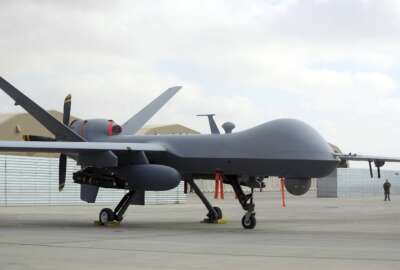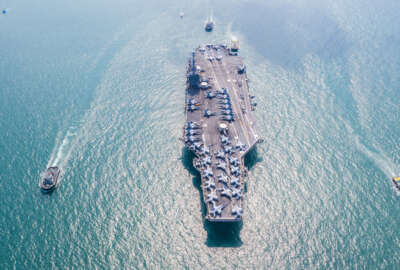Army to set up digital contracting center of excellence
While digital engineering and digital twins are important resources to accelerate the Department of Defense’s digital transformation, they come with risks tha...
The Army is setting up a digital contracting center of excellence over the next few months as it works to further digital engineering.
Young Bang, the assistant secretary of the Army for Acquisition, Logistics and Technology, says this will be a hub and resource to train officers and make contracting more seamless across different Army shops. It will also develop templates, foundations and train workers and eventually scale this out to other contracting shops.
Bang said that digital engineering and digital twins are key to the Army’s digital transformation.
“Digital engineering is the process throughout the whole lifecycle spanning more than just acquisition, spanning concepts, requirements, wargaming, modeling and simulations, into the material development to include everything in acquisitions, designs, testing, to the point of soldier feedback, and then going back through the whole cycle of testing and models and simulations,” Bang said at an AFCEA DC event in Arlington on Wednesday. “So, the outcome becomes more than a paper-based way of doing things. It becomes a digital instantiation of the concepts that we can take to accelerate.”
Bang said having these in a digital environment would enable the Army to iterate items faster and accelerate the design and refining process as well as production. He added that upskilling the current workforce and improving recruitment and retention efforts will also be an important part of this digital transformation effort.
Bang said that it is important to take a lesson from industry with some parts of industry that are ahead of the Army in their digital transformation efforts.
“Some vendors are like, ‘we’re already in the digital environment, it’d be easier for us to submit to you in a digital format that you can consume better, faster, so you’re not doing all these printouts and evaluations of CDRLs [contract data requirements list] or even proposals,’” Bang said. “And so we’re like, ‘hey, great idea. Let’s build on that.’”
He said that the Army is working to provide incentives to industry to embrace digital transformation if they have not already done so and to help the Army adopt it.
There are other efforts across Defense focusing on digital engineering and digital twins. For example, the Defense Advanced Research Projects Agency, or DARPA, is working on a digital twin from surface to space to illustrate energy coming through the atmosphere, whether its an earthquake or a meteor. The Naval Research Laboratory is working to increase edge intelligence — or pushing more autonomous capability into systems — in its robotics through digital engineering and digital twins.
However, there are limitations with models, which cannot answer every question or be applied to every situation.
“A model that we use in a digital twin is a function of the questions that you want to ask and what you want to learn from it,” said Joseph Hays, a research scientist at the Naval Research Laboratory. “A lot of times when people talk about digital twins, I think of some master model that can answer all the questions, and there’s a cost or a problem that comes with that. If you build in all of the capability into that digital twin that can answer all the questions, then you’re going to break other peoples’ ability to use that digital twin.”
There could also be challenges to the adoption of digital twins like overselling and overdesigning. For example, continually adding bells and whistles and trying news scenarios and simulations to an item in a digital twin state.
“It’s great that I can visualize all of that, or we could just build it and the maintainers will use their little shiny sticks and say, ‘nope, stop, you’re going to hit something,’” said Mikey Nayak, a program manager in the Strategic Technology Office at DARPA. “We don’t necessarily need to engineer it all the way, right? We did what we needed to do, which is we were able to put people inside the airplane, visualize the sea state and that was helpful for the loadmasters to say, ‘these are what my constraints are going to be.’ So, where do we say, ‘at this point, I think I’ve gotten all that I need to get out of it. I’ve accelerated my design timeline significantly; I’m now going to pivot to something that’s real.’”
Going forward, Nayak said that having digital twins is helpful for solving problems quickly.
“Speaking from the DARPA perspective, it is so much more useful when somebody pitches me on a digital system that can iterate on a weekly basis and answer the question to just a second order level, because what I’m looking for is the big bet,” Nayak said.
He added that sometimes a model can be too complicated and perform too many computations, which take a long time and means the user does not get an answer to provide feedback for a while, and that can be an issue. “Reducing the computational burden of digital twins, it’s less fidelity, but it’s more utility, like the average soldier, sailor, airman could actually say, ‘yes, that matters to me, do more of that.’”
Harry Wingo, faculty member of the College of Information and Cybersecurity at the National Defense University, said that digital twins for governance will be helpful. For example, with something like the FITARA scorecard or to see if DoD will be able to meet its goals for its Replicator project, which aims to scale drones within the next two years.
“What if you had a digital twin for governance where you look at the cycle of what’s likely in Congress, deadlock, all those things, and have that as a platform?” Wingo said.
Wingo added that getting universities involved to help solve problems in a more low-stakes environment could be beneficial. Meanwhile digital twins can be helpful for designing and producing physical items.
“I come from a design and engineering perspective, so, all the uses of digital twins for me comes from that context,” Hays said. “Aerospace, automotive, obviously robotics, that’s what I do. Anytime that you’ve got to build up something physical, where physics is involved, digital twins come into play there to allow engineers and designers to ask the questions they need.”
Copyright © 2024 Federal News Network. All rights reserved. This website is not intended for users located within the European Economic Area.
Kirsten Errick covers the Defense Department for Federal News Network. She previously reported on federal technology for Nextgov on topics ranging from space to the federal tech workforce. She has a Master’s in Journalism from Georgetown University and a B.A. in Communication from Villanova University.
Follow @kerrickWFED






